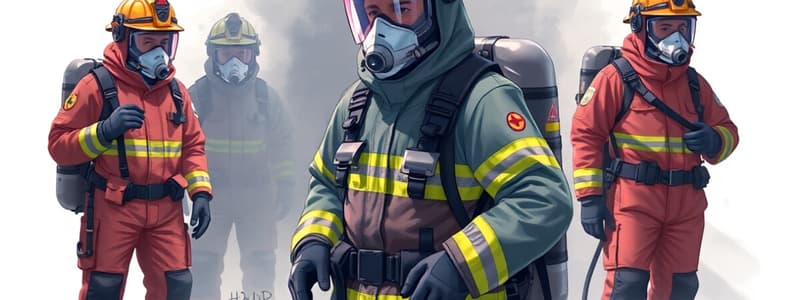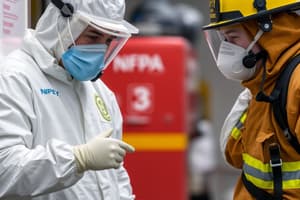Podcast
Questions and Answers
Who is primarily responsible for establishing the Decontamination Sector at a working fire?
Who is primarily responsible for establishing the Decontamination Sector at a working fire?
- The Company Officer
- The ISO
- The Post Incident Decontamination Officer
- The Incident Commander (IC) (correct)
According to the content, where should decontamination and initial firefighter hygiene be conducted?
According to the content, where should decontamination and initial firefighter hygiene be conducted?
- Rehabilitation Zone
- Cold Zone
- Hot Zone
- Warm Zone (correct)
What is the first step that firefighters should take after exposure to VOHs or PAHs?
What is the first step that firefighters should take after exposure to VOHs or PAHs?
- Report the exposure to the ISO
- Undergo initial firefighter hygiene (correct)
- Enter their vehicle's cab
- Decontaminate their equipment
What is the role of the Post Incident Decontamination Officer?
What is the role of the Post Incident Decontamination Officer?
What is NOT a requirement for personnel before entering the cab of a vehicle after exposure to VOHs or PAHs?
What is NOT a requirement for personnel before entering the cab of a vehicle after exposure to VOHs or PAHs?
Which of the following zones is considered a 'Cold Zone'?
Which of the following zones is considered a 'Cold Zone'?
Who can initiate decontamination on scene?
Who can initiate decontamination on scene?
Which of the following is NOT included in the initial firefighter hygiene and decontamination mitigation measures on scene?
Which of the following is NOT included in the initial firefighter hygiene and decontamination mitigation measures on scene?
What is the main reason for establishing a Decontamination Sector at working fires?
What is the main reason for establishing a Decontamination Sector at working fires?
According to the content, what would be considered a non-emergency situation when entering the cab of a TFS vehicle?
According to the content, what would be considered a non-emergency situation when entering the cab of a TFS vehicle?
What is the primary purpose of the decontamination kit?
What is the primary purpose of the decontamination kit?
What is the recommended procedure for handling contaminated station uniforms?
What is the recommended procedure for handling contaminated station uniforms?
What is the correct procedure for transporting contaminated PPE?
What is the correct procedure for transporting contaminated PPE?
What does the term 'containment' refer to in relation to post-incident decontamination?
What does the term 'containment' refer to in relation to post-incident decontamination?
What is the main concern regarding contamination of station uniforms?
What is the main concern regarding contamination of station uniforms?
What is the recommended action for firefighters who have been exposed to PAHs and VOCs?
What is the recommended action for firefighters who have been exposed to PAHs and VOCs?
What is the most appropriate procedure for firefighters to mitigate exposure to contaminants after a structure fire?
What is the most appropriate procedure for firefighters to mitigate exposure to contaminants after a structure fire?
What is the main component of the decontamination kit used to remove contaminants?
What is the main component of the decontamination kit used to remove contaminants?
What is the purpose of using FireWipes in the decontamination kit?
What is the purpose of using FireWipes in the decontamination kit?
What are PAHs?
What are PAHs?
What is the main goal of the decontamination procedures outlined in the document?
What is the main goal of the decontamination procedures outlined in the document?
Which role is primarily responsible for ensuring personnel understand and adhere to the decontamination guidelines?
Which role is primarily responsible for ensuring personnel understand and adhere to the decontamination guidelines?
What is the document's specific focus regarding decontamination procedures for structural firefighting PPE?
What is the document's specific focus regarding decontamination procedures for structural firefighting PPE?
What is the primary responsibility of District Chiefs in relation to the decontamination process?
What is the primary responsibility of District Chiefs in relation to the decontamination process?
According to the document, what kind of behavior should firefighters adopt regarding post-fire decontamination?
According to the document, what kind of behavior should firefighters adopt regarding post-fire decontamination?
What is the specific reason given in the document for firefighters and investigators needing to engage in post-incident exposure mitigation?
What is the specific reason given in the document for firefighters and investigators needing to engage in post-incident exposure mitigation?
According to the document, when should personnel follow decontamination procedures?
According to the document, when should personnel follow decontamination procedures?
Which individuals or roles are specifically mentioned as being responsible for promoting the importance of post-fire decontamination?
Which individuals or roles are specifically mentioned as being responsible for promoting the importance of post-fire decontamination?
What is the document's stance on the frequency of cleaning firefighters and their equipment?
What is the document's stance on the frequency of cleaning firefighters and their equipment?
What is the file code for the document?
What is the file code for the document?
Flashcards
Post-Incident Decontamination
Post-Incident Decontamination
The process of removing contaminants from personnel, vehicles, equipment, and PPE after an incident.
Warm Zone
Warm Zone
Area where firefighters undergo initial decontamination and hygiene procedures. It's between the hot and cold zones.
Cold Zone
Cold Zone
Area where firefighters and equipment are considered clean, free from contaminants.
Decontamination Officer
Decontamination Officer
Signup and view all the flashcards
Decontamination Sector
Decontamination Sector
Signup and view all the flashcards
Rehabilitation Sector
Rehabilitation Sector
Signup and view all the flashcards
Staging Sector
Staging Sector
Signup and view all the flashcards
Decontamination Apparatus
Decontamination Apparatus
Signup and view all the flashcards
Incident Commander (IC)
Incident Commander (IC)
Signup and view all the flashcards
Incident Safety Officer (ISO)
Incident Safety Officer (ISO)
Signup and view all the flashcards
What is a contaminant?
What is a contaminant?
Signup and view all the flashcards
What is decontamination?
What is decontamination?
Signup and view all the flashcards
What is containment?
What is containment?
Signup and view all the flashcards
Define hygiene.
Define hygiene.
Signup and view all the flashcards
Define mitigation.
Define mitigation.
Signup and view all the flashcards
Define PAHs.
Define PAHs.
Signup and view all the flashcards
Define VOCs.
Define VOCs.
Signup and view all the flashcards
What is a decontamination kit?
What is a decontamination kit?
Signup and view all the flashcards
What is firefighter hygiene?
What is firefighter hygiene?
Signup and view all the flashcards
How should contaminated uniforms be handled?
How should contaminated uniforms be handled?
Signup and view all the flashcards
Personal Protective Equipment (PPE)
Personal Protective Equipment (PPE)
Signup and view all the flashcards
Contaminants
Contaminants
Signup and view all the flashcards
Why is Post-Incident Decontamination Important?
Why is Post-Incident Decontamination Important?
Signup and view all the flashcards
Who Promotes Decontamination?
Who Promotes Decontamination?
Signup and view all the flashcards
Firefighter Hygiene
Firefighter Hygiene
Signup and view all the flashcards
Responsibilities for Decontamination
Responsibilities for Decontamination
Signup and view all the flashcards
Supervisor's Role in Decontamination
Supervisor's Role in Decontamination
Signup and view all the flashcards
District Chiefs' Role in Decontamination
District Chiefs' Role in Decontamination
Signup and view all the flashcards
Health Risks of Contaminants
Health Risks of Contaminants
Signup and view all the flashcards
Study Notes
Post Incident Decontamination
- Date Issued: August 29, 2022
- Rescinds: November 1, 2018
- Section: Incident and Emergency Operations
- File Code: G-POST
Purpose
- Decontamination procedures are developed for structural firefighting PPE, focusing on firefighter and fire investigator safety.
- Company officers, fire investigators, incident safety officers, and incident commanders are to promote post-fire decontamination and firefighter hygiene.
- Toronto Fire Services personnel must consistently clean themselves and their equipment.
- Decontamination procedures will be followed if equipment has been or may have been contaminated.
Responsibility
- All TFS personnel are responsible for understanding and following the Standard Operating Guideline.
- All personnel are to use and/or wear provided equipment and protective devices as necessary.
- Supervisors must ensure personnel understand and adhere to the guideline and procedures.
- Supervisors ensure personnel use proper protective devices, measures, or clothing.
- Supervisors must take all reasonable precautions to protect all personnel.
- District Chiefs will monitor decontamination process timeliness to quickly return crews to readiness.
General Guidelines
- Maintaining the cleanliness of PPE and equipment is critical, impacting firefighter health.
- Officers and firefighters are required for post-incident exposure mitigation.
- Officers ensure personnel return to station for decontamination (shower, vehicle, equipment, PPE).
- Personnel shall not enter vehicle cabs when exposed to VOHs or PAHs without undergoing initial decontamination.
- Officers are not to request non-emergency situations entering TFS vehicles without prior hygiene/decontamination.
- Decontamination sectors (hot, warm, cold) are established at working fires.
Decontamination Sector
- The Incident Commander (IC) will identify hot, warm, and cold zones for decontamination.
- Decontamination and initial firefighter hygiene occur only in the warm zone.
- On-scene decontamination is the individual firefighter's responsibility.
- The Incident Safety Officer (ISO) for working fires is responsible for decontamination (warm zone), rehabilitation (warm zone), and staging (cold zone) sectors.
Decontamination Kits
- Each apparatus is supplied with a post-incident decontamination kit (includes pails, brushes, nozzles, soap, wipes, rags).
- Contaminated station uniforms should be machine washed.
- Contaminated PPE, SCBA, or other equipment should not be transported in fire department vehicles without containment.
Definitions
- Containment: Physically separating contaminants.
- Contaminant: A polluting or poisonous substance.
- Decontamination: Neutralizing or removing contaminants.
- Hygiene: Practices conducive to preventing disease.
- Mitigation: Reducing the severity of something.
- Soiled: PPE exposed to sweat, odors, dust, debris (combustion products).
- VOCs: Volatile organic compounds (numerous, varied, ubiquitous, human-made and naturally occurring)
- PAHs: Polycyclic aromatic hydrocarbons (from coal, oil, gasoline, combustion).
Studying That Suits You
Use AI to generate personalized quizzes and flashcards to suit your learning preferences.




